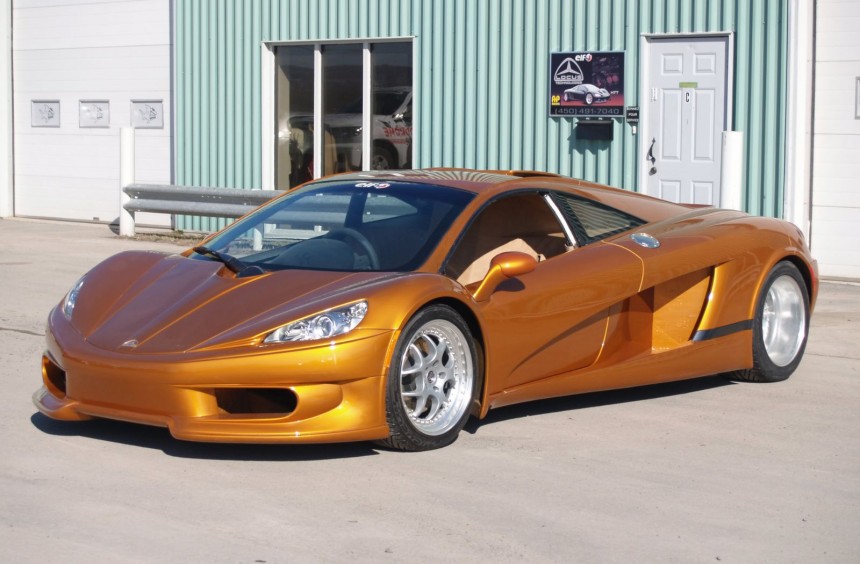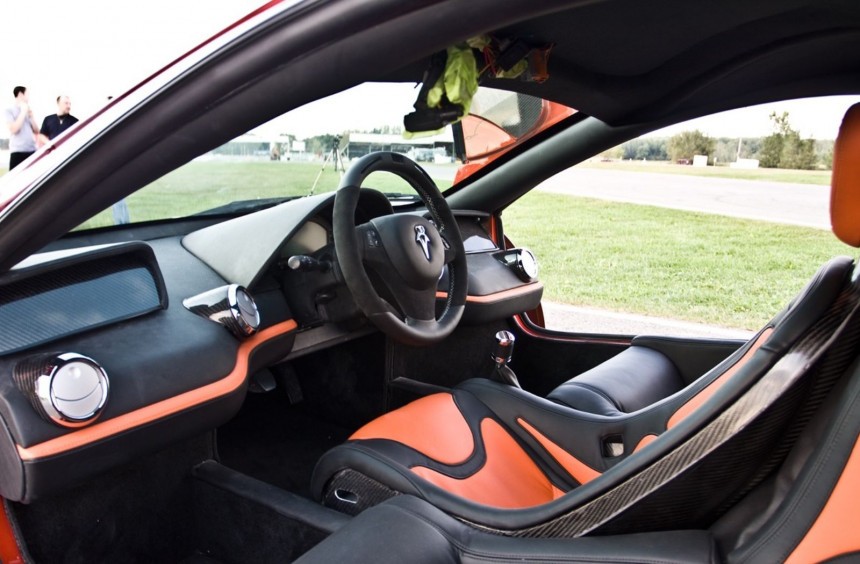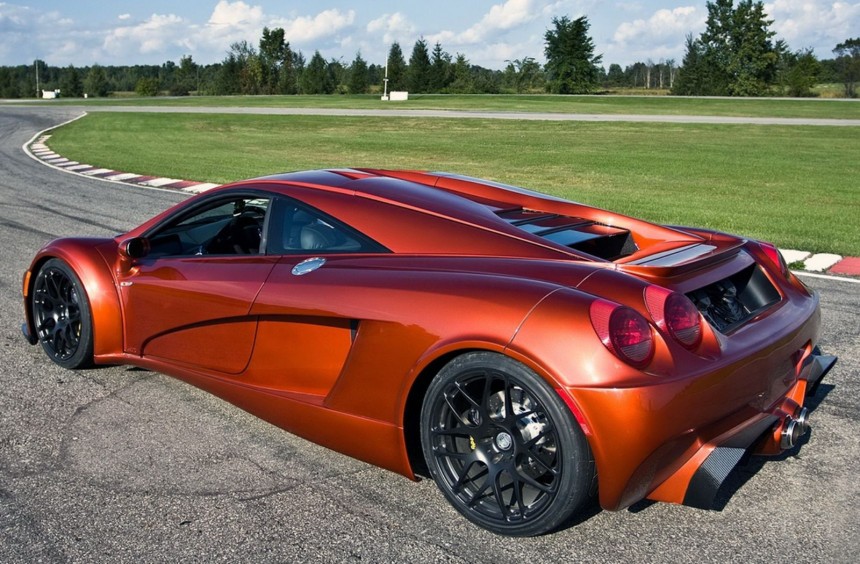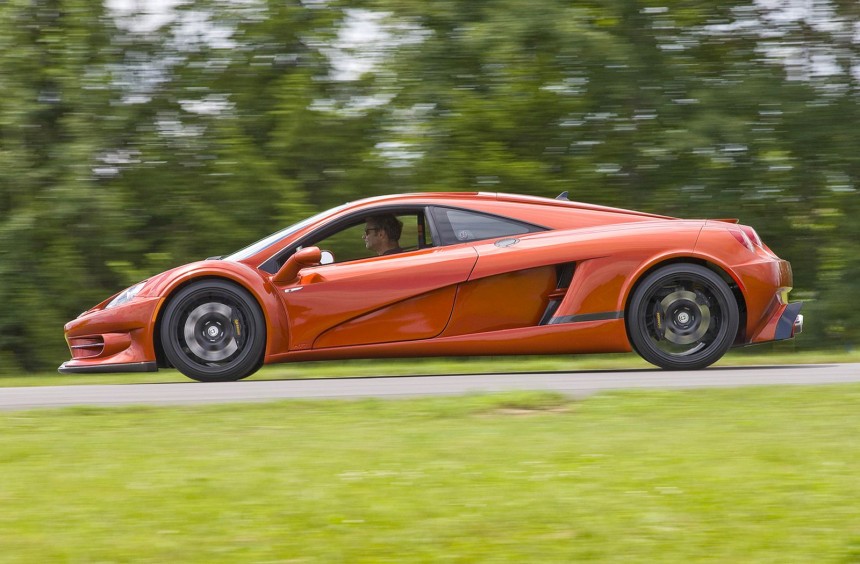Doning an all-carbon-fiber body and one of the era's most potent production V8s mounted in the middle, behind the three-seat cockpit, the Pléthore looked extremely good on paper, but it failed to make it in the real world.
Canada is famous for a lot of things, but not sports cars. Nevertheless, several local entrepreneurs have attempted to design and build one throughout the years.
In the 1970s, Malcolm N. Bricklin, a successful American businessman known for bringing Subaru to North America, partnered with the Canadian government and created the quirky Bricklin SV-1.
Dubbed the safest sports car ever built at the time of its release, the SV-1 was built in Canada and attempted to become a cheaper alternative for Chevy's Corvette.
Unfortunately, it was a commercial failure, with only 3,000 units of the planned 10,000 ever making it to the streets, so the model - wchich ended up being more expensive than a base 'Vette - was discontinued afer about a year on the market.
In the following decades, other attempts were made to build Canadian sports cars and supercars, but none succeeded.
Among these attempts, arguably the most ambitious and fascinating was the HTT Pléthore.
Like all fascinating automotive stories, this one began with two enthusiasts, Luc Chartrand and Carl Descoteaux, who decided to build their own supercar.
In the first part of the 2000s, the duo established Locus (later renamed HTT Automobile) in Quebec, hired some like-minded people with engineering skills, and began turning their collective dream into reality.
A few years later, at the 2007 Montreal International Auto Show, the team unveiled a full-size prototype of what they hoped would become the first production supercar designed and assembled in Canada.
Initially dubbed Locus Pléthore (plethora, in French), the supercar was a pleasant surprise in terms of visual beauty - especially since it was developed by a small startup with no prior experience in car manufacturing.
Fabricated entirely from carbon fiber, the body designed by Luc Chartrand seemed to mix eye-catching visual cues inspired by the decade's most impressive high-performance sports cars with original lines and shapes.
Also made from carbon fiber, the chassis was built around an advanced monocoque. It featured a complex independent suspension system and high-performance breaks with massive drilled discs visible through the spokes of the custom-made wheels.
Unquestionably the most influential high-performance sports car of all time, the McLaren F1 served as an inspiration for many supercars, and the Pléthore was no exception.
Its cockpit borrowed the famed V12-powered legend's central driving position flanked by slightly rearward passenger seats on each side.
However, the initial prototype unveiled in 2007 didn't feature a finished interior. Instead, the company presented computer-generated renderings that previewed a very futuristic cabin.
Years later, the aspiring carmaker, renamed HTT Automobile, managed to complete the interior. Although it retained the original three-seat layout, it looked nothing like the futuristic renderings.
Nevertheless, even in its far simpler form, the Pléthore's cockpit was in tune with the decade's trends. It featured a mix of leather and Alcantara upholstery, as well as a custom steering wheel with built-in LED shift indicators.
Between the three-seat cockpit and the rear axle, the initial Pléthore hid an American eight-cylinder supercharged heart.
Rated at 750 hp and 655 lb-ft (888 Nm) of torque and linked to a Tremec six-speed manual, the heart of the Canadian supercar was borrowed from what was at the time the most powerful version of America's favorite sports car, the C6 Corvette ZR1.
Several years after its debut, the initial car was renamed HTT Pléthore LC-750 to distinguish it from a future version that the company announced would feature a 1,100-hp "homemade" V8.
HTT was subsequently criticized for the wording, with the press arguing that no sane customer would want to buy a supercar powered by a homemade engine, especially if the vehicle came from a startup.
Therefore, the company revealed that the so-called homemade engine was actually an LS-based supercharged unit developed by experts from Pratt & Miller.
Although performance figures were never released, HTT estimated that the 2755-pound (1,250 kg) Canadian beast would have a power-to-weight ratio equivalent to a Formula 1 car when equipped with the 1,100-hp V8.
Therefore, they decided to pitch the Pléthore to investors on the popular Canadian show Dragons Den (known as Shark Tank in the US). But, of all the investors present, just Robert Herjavec was intrigued.
A well-known car enthusiast, Herjavec eventually agreed to finance the project and convinced W. Brett Wilson, another wealthy investor, to join the venture, but he told the founders that he wanted to drive the car before sealing the deal.
A test run on a closed track was scheduled, but unfortunately, when the investor climbed in and attempted to drive off, the six-speed transmission refused to comply, and the car failed to start.
Engineers couldn't fix the issue on-site, and Herjavec decided to pull out of the project.
Despite this major drawback, HTT managed to secure enough funding to build another revised pre-production prototype.
Introduced to the public at the Canadian Grand Prix in 2013, the new Pléthore LC-1300 featured the same bodywork as the previous car, but as the name implied, it was presumably powered by a 1,300-hp engine.
The unit in question was a tuned version of the Dodge Viper's V10 mated to an all-wheel-drive system, but since no other details were revealed, we don't know for sure if it was based on a Dodge or Lambo ten-cylinder or if it actually made 1,300 ponies.
Despite the revised version, Chartrand and Descoteaux failed to attract investors and kick off a production run, so the supercar never made it out of the prototype stage.
Though it didn't become Canada's first production supercar, the gorgeous and incredibly powerful HTT Pléthore remains a great example of perseverance, and its fascinating story deserves to be told.
In the 1970s, Malcolm N. Bricklin, a successful American businessman known for bringing Subaru to North America, partnered with the Canadian government and created the quirky Bricklin SV-1.
Dubbed the safest sports car ever built at the time of its release, the SV-1 was built in Canada and attempted to become a cheaper alternative for Chevy's Corvette.
Unfortunately, it was a commercial failure, with only 3,000 units of the planned 10,000 ever making it to the streets, so the model - wchich ended up being more expensive than a base 'Vette - was discontinued afer about a year on the market.
In the following decades, other attempts were made to build Canadian sports cars and supercars, but none succeeded.
Among these attempts, arguably the most ambitious and fascinating was the HTT Pléthore.
How it all started
In the first part of the 2000s, the duo established Locus (later renamed HTT Automobile) in Quebec, hired some like-minded people with engineering skills, and began turning their collective dream into reality.
A few years later, at the 2007 Montreal International Auto Show, the team unveiled a full-size prototype of what they hoped would become the first production supercar designed and assembled in Canada.
Carbon fiber galore
Fabricated entirely from carbon fiber, the body designed by Luc Chartrand seemed to mix eye-catching visual cues inspired by the decade's most impressive high-performance sports cars with original lines and shapes.
Also made from carbon fiber, the chassis was built around an advanced monocoque. It featured a complex independent suspension system and high-performance breaks with massive drilled discs visible through the spokes of the custom-made wheels.
A McLaren F1-inspired interior
Its cockpit borrowed the famed V12-powered legend's central driving position flanked by slightly rearward passenger seats on each side.
However, the initial prototype unveiled in 2007 didn't feature a finished interior. Instead, the company presented computer-generated renderings that previewed a very futuristic cabin.
Years later, the aspiring carmaker, renamed HTT Automobile, managed to complete the interior. Although it retained the original three-seat layout, it looked nothing like the futuristic renderings.
Nevertheless, even in its far simpler form, the Pléthore's cockpit was in tune with the decade's trends. It featured a mix of leather and Alcantara upholstery, as well as a custom steering wheel with built-in LED shift indicators.
Corvette ZR1 power
Rated at 750 hp and 655 lb-ft (888 Nm) of torque and linked to a Tremec six-speed manual, the heart of the Canadian supercar was borrowed from what was at the time the most powerful version of America's favorite sports car, the C6 Corvette ZR1.
Several years after its debut, the initial car was renamed HTT Pléthore LC-750 to distinguish it from a future version that the company announced would feature a 1,100-hp "homemade" V8.
HTT was subsequently criticized for the wording, with the press arguing that no sane customer would want to buy a supercar powered by a homemade engine, especially if the vehicle came from a startup.
Therefore, the company revealed that the so-called homemade engine was actually an LS-based supercharged unit developed by experts from Pratt & Miller.
Although performance figures were never released, HTT estimated that the 2755-pound (1,250 kg) Canadian beast would have a power-to-weight ratio equivalent to a Formula 1 car when equipped with the 1,100-hp V8.
Attempting to secure funding for a production run
By 2011, Chartrand and Descoteaux were struggling to gather financial backing for a 99-unit production run.
Therefore, they decided to pitch the Pléthore to investors on the popular Canadian show Dragons Den (known as Shark Tank in the US). But, of all the investors present, just Robert Herjavec was intrigued.
A well-known car enthusiast, Herjavec eventually agreed to finance the project and convinced W. Brett Wilson, another wealthy investor, to join the venture, but he told the founders that he wanted to drive the car before sealing the deal.
A test run on a closed track was scheduled, but unfortunately, when the investor climbed in and attempted to drive off, the six-speed transmission refused to comply, and the car failed to start.
Engineers couldn't fix the issue on-site, and Herjavec decided to pull out of the project.
Switching to V10 power
Introduced to the public at the Canadian Grand Prix in 2013, the new Pléthore LC-1300 featured the same bodywork as the previous car, but as the name implied, it was presumably powered by a 1,300-hp engine.
The unit in question was a tuned version of the Dodge Viper's V10 mated to an all-wheel-drive system, but since no other details were revealed, we don't know for sure if it was based on a Dodge or Lambo ten-cylinder or if it actually made 1,300 ponies.
Despite the revised version, Chartrand and Descoteaux failed to attract investors and kick off a production run, so the supercar never made it out of the prototype stage.
Though it didn't become Canada's first production supercar, the gorgeous and incredibly powerful HTT Pléthore remains a great example of perseverance, and its fascinating story deserves to be told.

























